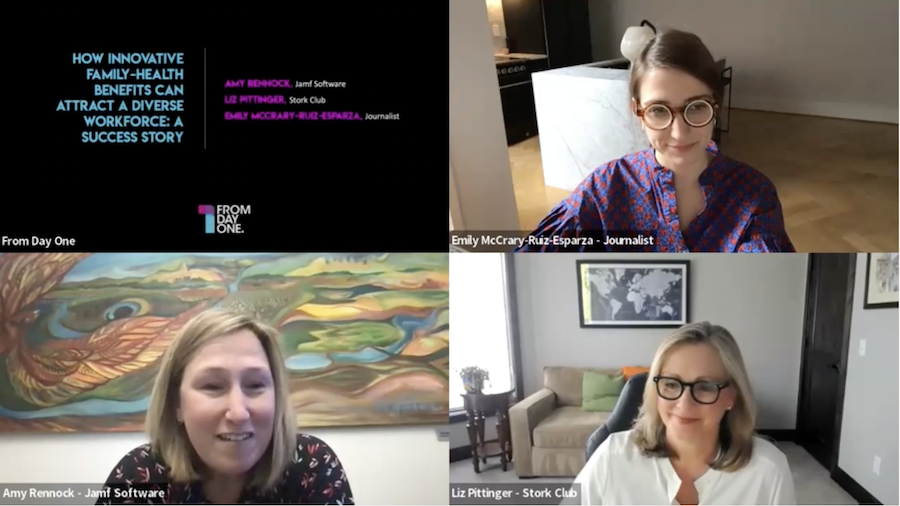How a Family-friendly Company Used Innovative Health Benefits to Attract a Diverse Workforce


It began with a goal to increase the number of women in their workforce. The plan was to create a suite of benefits that appeal to women, starting with maternity health coverage and adjacent services.
“That started us on our journey. As we heard from our employee resource groups, that’s something that was valuable to them,” said Amy Rennock, chief HR officer at Jamf Software, which builds Apple device management technology.
The company’s search for an inclusive, family-building health plan changed the way Jamf thinks about providing health care. “We have a lot of men who have families that are served by this benefit. We have a lot of trans employees who are getting services and feeling supported. We’ve changed the definition of what family is. It really broadened our horizons.”
Rennock told the story of how Jamf made its slate of inclusive family-building and reproductive-care benefits during a recent From Day One webinar, alongside Liz Pittinger, head of global customer success at Stork Club, Jamf’s family-building benefits partner.
Pittinger said Jamf’s story is representative of the path many companies are taking. They begin with the goal of supporting diversity, equity, and inclusion (DEI), they see the advantage of these benefits for retention and attraction, and they gain a broader understanding of how diverse the needs of their workforce really are. With that, they become a better employer.
As Jamf added new benefits and shared them with employees, people started speaking up about their needs. They felt the license to do so. The fact that the company was expanding benefits beyond maternity care demonstrated that it was thinking inclusively.
“We knew we had the demographics there,” Rennock said about her workforce, which includes mothers, fathers, trans people, non-binary people, single parents, and same-sex couples. “We didn’t know that they had needs we hadn’t been serving, until we made some of these things available.”
Like this one: Members of the LGBTQ community at Jamf told her that the new services covered were all well and good, but their problem wasn’t necessarily a problem of coverage. They needed health care providers who are compassionate toward their individual identities.

“What we looked for wasn’t just to add another service to cover on the health plan, it became ‘Who can we partner with for care navigation? Who can hold someone’s hand through the complicated U.S. medical system to get them the care that they need and deserve in a humane way?’” said Rennock. “That population continues to experience bias and discrimination, even against the very providers that are providing service to them.”
Similarly, Rennock and Pittinger noted the disparity in maternal health outcomes between white women and women of color. Kaiser Family Foundation and other organizations have reported that Black, Native American, and Alaska Native women experience rates of pregnancy-related death two to three times higher than their white peers do. The more agency women of color have in their fertility journey, the better. More choices, like access to a network of doulas, for example, give them greater control over their reproductive health.
Pittinger noted that coverage of services like IVF and egg freezing are inclusive only when available to anyone who elects for them. Traditionally, however, fertility benefits in a health plan are accessible only following an infertility diagnosis, she said. “OK, that’s fantastic, but where does that leave the single man or woman who is aging and needs to do egg or sperm freezing to preserve fertility? Where does that create a path for a single parent? How does that create a path for same-sex couples?” she said.
What about those who aren’t in a family-planning stage of life? How do they partake in reproductive care benefits? Education, for one. Pittinger recommended providing employees with educational resources about care like egg and sperm freezing, menopause, gender confirmation, and mental health related to reproductive care “so they understand what their options are early enough so that whenever their life changes, or if they make that decision that they do want to start a family, they have more opportunities to do it because of the foundation they laid 10 years earlier.”
Family care benefits are a matter of competition among employers, who are are using inclusive packages to stand out in the job market. Yet discretion has to be part of the conversations with prospective workers. There are questions that cannot and should not be asked during an interview–one’s current family situation and future family plans chiefly among them. “But we have lots of opportunities to get feedback from people who are in and out of our recruitment process, what things they’re seeing, how we’re benchmarking with other organizations,” said Rennock, remarking that she finds inspiration among companies she admires and wants to emulate.
Even if you’re not actively in family-planning mode, having a package like this on the table with a job offer can tip the scales, said Rennock. “We hear really positive feedback from new joiners that ‘This was one of those things that tilted my decision in your favor, because I could tell, even if I don’t have a family right now or don’t have plans to have a family, it says to me that you care about your employees.”
Editor’s note: From Day One thanks our partner, Stork Club, who sponsored this webinar.
Emily McCrary-Ruiz-Esparza is a freelance journalist and From Day One contributing editor who writes about work, the job market, and women’s experiences in the workplace. Her work has appeared in The Washington Post, Quartz at Work, Fast Company, Digiday’s Worklife, and Food Technology, among others.
(Featured photo by Aleksandar Nakic/iStock by Getty Images)
The From Day One Newsletter is a monthly roundup of articles, features, and editorials on innovative ways for companies to forge stronger relationships with their employees, customers, and communities.